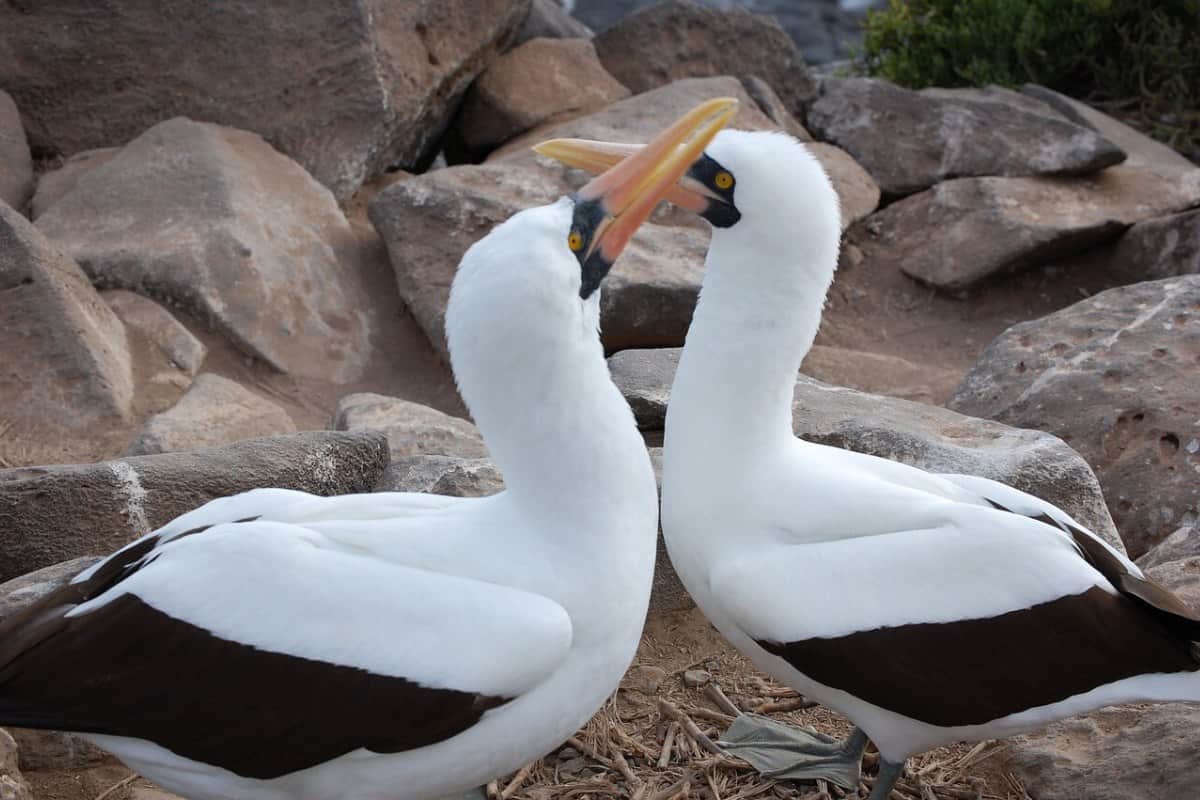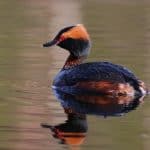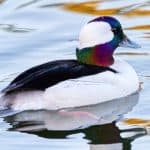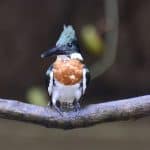Common Name: Nazca Booby
Scientific Name: (Sula granti)| Size | Diet | Range in Hawaii | Status in Hawaii |
|---|---|---|---|
| 31 in. | anchovies, sardines, and flying fish | Hawai'i I (Big Island) and O’ahu | Least Concern |
The Nazca Booby, also known as Sula granti, is a seabird species that is native to the Galapagos Islands and the surrounding waters of the eastern Pacific Ocean. While the species is not native to Hawaii, it has been known to make occasional appearances on the islands as a non-breeding visitor and vagrant. With its striking appearance and unique behavior, the Nazca Booby is a fascinating bird species that has captured the attention of birdwatchers and avian enthusiasts around the world.
In this article, we will explore the world of the Nazca Booby, its unique characteristics, and its occasional presence in Hawaii.
Nazca Booby
Appearance
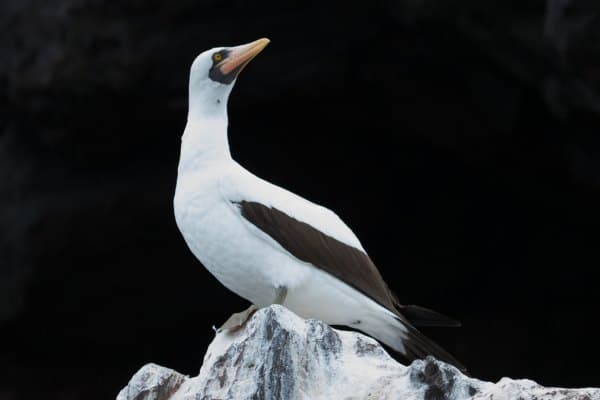
With its striking plumage, this booby species is a true spectacle to behold. Its overall coloration is characterized by bright white feathers covering its body, complemented by contrasting black markings on its wings, tail, and face.
One of the most distinctive features of the Nazca Booby is its vivid blue beak, which stands out beautifully against the sea of white feathers. With a wingspan reaching up to an impressive 61 inches (155 cm), the Nazca Booby soars majestically through the air, gracefully riding the ocean breeze. Despite their large wingspan, they are relatively compact birds, measuring around 31 inches (79 cm) in length.
Diet
As a seabird native to the eastern Pacific Ocean, this species predominantly feeds on an array of marine creatures that thrive in these nutrient-rich waters. The primary food source for the Nazca Booby consists of small to medium-sized fish, such as anchovies, sardines, and flying fish. Not limited to just fish, the Nazca Booby also supplements its diet with squid and other cephalopods found in the ocean.
Nesting
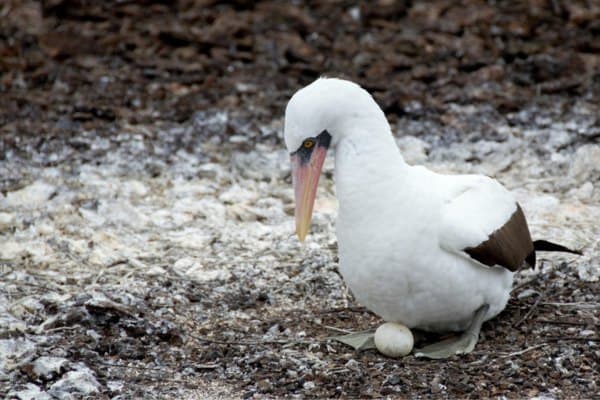
Unlike many other bird species, Nazca Boobies do not construct traditional nests in trees or on the ground. Instead, they are skilled cliff-dwellers, choosing to build their nests on rocky ledges and crevices. These sites provide essential protection from predators and help keep the eggs and chicks safe during their vulnerable early stages of development.
The nesting process begins with the male booby courting the female through an elaborate display of courtship rituals, which can include vocalizations, preening, and impressive aerial displays. Once a pair has formed a bond, they work together to build a nest made of twigs, sticks, and other available materials. While these materials might seem simple, the birds’ mastery in arranging them creates a sturdy and reliable nest structure.
Remarkably, the Nazca Booby is known for its adaptability, often choosing nesting sites near human settlements or even on man-made structures like abandoned boats or old buildings. This ability to coexist with human presence showcases their unique ability to thrive in both natural and human-altered environments.
The breeding colonies of Nazca Boobies can be truly awe-inspiring sights, with hundreds or even thousands of pairs gathering together on steep cliffs, each tending to their precious eggs or fluffy white chicks. This incredible concentration of life is a testament to the resilience and cohesion of this bird species.
As the chicks grow, both parents play active roles in providing them with nourishment and protection. Once the chicks fledge and become independent, they will spend a significant portion of their lives at sea, before returning to their nesting grounds to continue the cycle of life.
Behavior
One of the most remarkable behaviors of the Nazca Booby is its incredible diving prowess. These birds are exceptional hunters, and when they spot schools of fish or other prey from the air, they execute dramatic plunges into the ocean. Their streamlined bodies and powerful wings allow them to perform these aerial dives with precision, enabling them to catch fish and squid with remarkable efficiency.
Another notable behavior is their elaborate courtship rituals. During the breeding season, male Nazca Boobies engage in intricate displays to attract potential mates. These displays may involve vocalizations, preening, and elegant aerial acrobatics. Once a pair has formed a bond, they will remain monogamous for the duration of the breeding season.
The nesting behavior of the Nazca Booby is also a highlight of their repertoire. As mentioned earlier, they are adept cliff-dwellers, constructing their nests on rocky ledges and crevices. This behavior helps protect their eggs and chicks from predators while providing a safe environment for their young to grow.
Nazca Boobies are known for their resilience and adaptability. They have shown a remarkable ability to coexist with human presence and have been observed nesting on man-made structures such as abandoned boats and buildings. This adaptability highlights their resourcefulness and ability to thrive in various environments.
In addition to their hunting and nesting behaviors, Nazca Boobies also exhibit social behaviors within their breeding colonies. These colonies can consist of hundreds or even thousands of individuals, creating a bustling community of seabirds. Their interactions within the colony include vocalizations, displays of dominance, and cooperative efforts in raising their chicks.
Habitat

The Nazca Booby thrives in the eastern Pacific Ocean, with a primary habitat on the Galápagos Islands. These seabirds are cliff-dwellers, nesting on rocky ledges and crevices for protection. Their adaptability and unique habitat make them a fascinating part of marine ecosystems.
Range
The Nazca Booby is a non-breeding visitor and vagrant to Hawaii. While they primarily breed in the tropical eastern Pacific, mainly on the Galapagos Islands, a few adult individuals have been documented in the Hawaiian Islands. These sightings include birds observed on Tern Island, French Frigate, Mokumanu islet off O’ahu, Eastern Island, and Midway.
Conservation Status
The conservation status of the Nazca Booby (Sula granti) is considered to be of “Least Concern” according to the International Union for Conservation of Nature (IUCN). This classification means that the species is not currently facing any significant threats that would endanger its population.
Interesting Facts
1. Taxonomic split
The Nazca Booby was long considered a subspecies of the Masked Booby (Sula dactylatra). However, in 2000, the American Ornithologists’ Union (AOU) recognized it as a separate full species based on morphological and genetic evidence.
2. Diving experts
These seabirds are skilled hunters and can dive from impressive heights of up to 100 feet (30 meters) into the ocean to catch fish and squid with remarkable accuracy.
3. Circular nests
Nazca Boobies construct their nests in circular shapes, creating a shallow depression where they lay their eggs. This unique design helps to keep the eggs from rolling away on the rocky nesting sites.
4. Nocturnal nesting
Nazca Boobies are known for their unique nocturnal nesting behavior. They often return to their nests during the nighttime, which is unusual for diurnal seabird species.
5. “Booby love” dance
In a peculiar courtship ritual, a male Nazca Booby will offer a stick or small rock to the female, and if she accepts it, they proceed to perform a synchronized dance.
Frequently Asked Questions
1. How long do Nazca Boobies typically live in the wild?
The average lifespan of Nazca Boobies in the wild is not well-documented, but similar booby species have been known to live for over 20 years.
2. How do Nazca Boobies navigate during their long migrations
Nazca Boobies have excellent navigational skills. They rely on various cues, including the Earth’s magnetic field and celestial landmarks, to navigate accurately during their long-distance migrations.
3. What role does the Nazca Booby play in the ecosystem it inhabits?
As top predators in their marine ecosystem, Nazca Boobies play a crucial role in controlling the populations of their prey species, contributing to the overall balance of the food web. Additionally, their nesting colonies serve as important habitats for other seabirds and wildlife.
4. Are Nazca Boobies affected by human activities such as fishing and coastal development?
Yes, Nazca Boobies can be affected by human activities. Overfishing and the use of fish aggregating devices can alter their natural foraging behaviors. Coastal development may also lead to habitat loss and disturbance to nesting colonies.
5. What is the significance of the Nazca Booby in the local culture and ecosystem of the Galápagos Islands?
The Nazca Booby is a key species in the Galápagos Islands’ ecosystem, contributing to nutrient cycling and acting as a bioindicator of the health of marine environments. It is also an essential component of the unique biodiversity that draws tourists to the Galápagos, contributing to the region’s cultural and economic significance.
